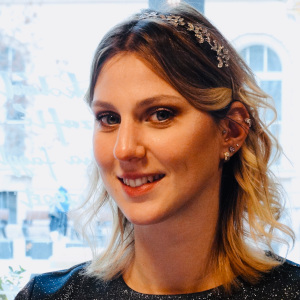Team > Dr. Eva Cseperke Vizsolyi
 Dr. Eva Cseperke Vizsolyi
Dr. Eva Cseperke Vizsolyi

Fakultät für Biologie, Chemie und Geowissenschaften
Lehrstuhl Tierökologie I
PostDoc
PhD in Chemistry
Project: microplastic@food - Development of a valid method for detecting different types of microplastics in foods
In the project microplastic@food simple food samples are analyzed for microplastic (MP) contamination starting from mineral water and beverages (fruit juices, beer, wine) through soluble food like salt and sugar until food surfaces. The participating industrial partners provide the samples from different part of the production next to the ready-to-consume product; therefore, we are also able to identify the entering points of microplastics into the food. As a scientific partner, our task is to develop sample preparation techniques which make the analyses of the microplastics possible in the different matrices. After the thorough sample preparation, the samples are analyzed by FTIR and Raman imaging techniques. Together with the industrial partners the goal is to decrease the amount of MPs in the product and at the end provide information to the decision makers about setting limits and making regulations.
In the project MicroWash we focused on analyzing fibers and especially plastic fibers originating from laundry. Many fibers are found in the wastewater stream of a large laundry, most of which are fed into the municipal wastewater treatment plants via the wastewater systems. The systems there are not designed to eliminate microparticles. The innovative flotation system is to use bubble technology to transport and separate the microfibers in the wastewater stream of the industrial laundry in a continuous process. The flotation system will be continuously submerged under water, which places special demands on the drive and the media supply. The wastewater processes of the laundries have to be adapted. To enable a quick installation, the flotation system is integrated into a process kit that can be installed as an "easy-to-fit" solution for the integration of known laundry systems. Within the project we developed an image analyzing software which helps to determine (count and measure) fibers in a simple way. The software is easy-to-use, and the sample preparation is also simple and can be used in a non-laboratory environment as well.
Previous project: MicroWash- Flotation of microfibers from industrial laundry

Fakultät für Biologie, Chemie und Geowissenschaften
Lehrstuhl Tierökologie I
Research topics:
- Method development: sampling, purification and spectroscopic analysis of food for microplastics
- Analyzing fibers by imaging techniques
- Analytical techniques like FTIR, Raman, GC-MS, LC-MS, ICP, classical analytics
- Water chemistry, remediation techniques
PhD in Chemistry:
During my PhD I worked on the removal of organic pollutants from groundwater by treatment with ferrate. In the first phase of my studies, I received samples from a highly polluted industrial area, where 44 different Volatile Organic Compounds (VOC) were detected, and the Chemical Oxygen Demand (COD) was ~4000 mg O2/L. In the second phase of my work, experiments using model solutions (containing ultrapure water, NaHCO3 and the analytes of interest) were carried out, to investigate the findings occurred during the groundwater experiments and to assess the effect of the commonly present cations (Ca2+, Mg2+, Zn2+, Ni2+) and the iron-oxy/hydroxide precipitation formed during the ferrate treatment on the removal of three different chlorobenzene (CB) compounds.

Fakultät für Biologie, Chemie und Geowissenschaften
Lehrstuhl Tierökologie I
Publikationen
2025
Christian Laforsch, Eva Cseperke Vizsolyi, Anja Ramsperger, Simon Wieland, Julian Brehm, Sven Ritschar, Holger Kress, Martin G. J. Löder: Environmental Fate and Effects of Microplastics on Organisms. In: Andrea Buettner, Eckhard Weidner (Hrsg.): Springer Handbook of Circular Plastics Economy. - Cham : Springer, 2025. - S. 793-807.
doi:10.1007/978-3-031-66209-6_40
2024
Simon David Jakob Oster, Paul E. Bräumer, Daniel Wagner, Max Rösch, Martina Fried, Vinay Kumar Bangalore Narayana, Eva Hausinger, Helena Metko, Eva Cseperke Vizsolyi, Matthias Schott, Christian Laforsch, Martin G. J. Löder: A novel proof of concept approach towards generating reference microplastic particles. In: Microplastics and Nanoplastics, 4 (2024). - .
doi:10.1186/s43591-024-00094-6
2022
Julia N. Möller, Ingrid Heisel, Anna Satzger, Eva Cseperke Vizsolyi, Simon David Jakob Oster, Seema Agarwal, Christian Laforsch, Martin G. J. Löder: Tackling the Challenge of Extracting Microplastics from Soils : A Protocol to Purify Soil Samples for Spectroscopic Analysis. In: Environmental Toxicology and Chemistry, 41 (2022). - S. 844-857.
doi:10.1002/etc.5024
2020
Eva Cseperke Vizsolyi, Krisztina Katona, Győző G. Láng, József Varga, Gyula Záray: Effect of cations and ferric-oxide/hydroxide precipitation on the removal of chlorobenzene compounds from model solutions applying ferrate treatment. In: Desalination and Water Treatment, 193 (2020). - S. 352-358.
doi:10.5004/dwt.2020.25802
2018
Péter Dobosy, Eva Cseperke Vizsolyi, Imre Varga, József Varga, Győző Láng, Gyula Záray: Comparative study of ferrate and thermally activated persulfate treatments for removal of mono- and dichlorobenzenes from groundwater. In: Microchemical Journal, 136 (2018). - S. 61-66.
doi:10.1016/j.microc.2016.10.015
2017
Eva Cseperke Vizsolyi, Péter Dobosy, Győző G. Láng, Imre Varga, József Varga, Gyula Záray: Laboratory scale study for remediation of polluted groundwater by ferrate treatment. In: Microchemical Journal, 133 (2017). - S. 231-236.
doi:10.1016/j.microc.2017.03.042
2016
Péter Dobosy, Eva Cseperke Vizsolyi, Imre Varga, József Varga, Győző G. Láng, Gyula Záray: Trichloroethylene removal from water by ferrate treatment. In: Microchemical Journal, 127 (2016). - S. 74-78.
doi:10.1016/j.microc.2016.02.010

Fakultät für Biologie, Chemie und Geowissenschaften
Lehrstuhl Tierökologie I
Dr. Eva Cseperke Vizsolyi
PostDoc
E-Mail: Eva.Cseperke-Vizsolyi@uni-bayreuth.de
ResearchGate: Dr. Eva Cseperke Vizsolyi
LinkedIn: Dr. Eva Cseperke Vizsolyi
